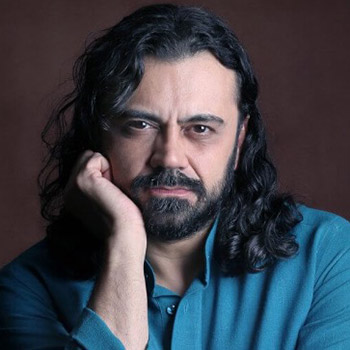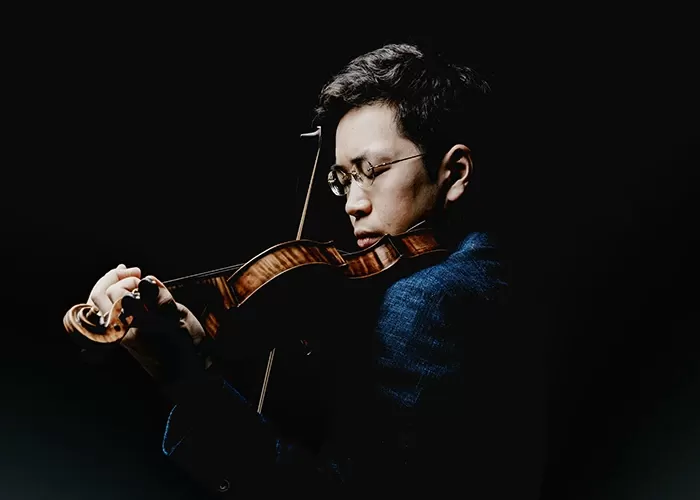
Pejman Hadadi
World-renowned, Pejman Hadadi is considered one of the most innovative Iranian percussionists. He was born in Tehran, Iran on February 19, 1969. At age 10, he began studying Tombak, the central drum in traditional Persian music, with Master Tombak player Assadollah Hejazi for two years. He owes the foundation of his training to this Master’s precise teaching. He continued his training for a brief time with Master Tombak player, Bahman Rajabi, who exposed him to an entirely different approach to playing the instrument. Hadadi tirelessly followed the various styles of famous Tombak players and was captivated by such great Masters as Hossein Tehrani, Nasser Farhangfar, and Morteza Ayan, who influenced him greatly through their recordings. After some time, he felt drawn to the other main percussive instrument in the tradition, namely the sacred frame drum known as the Daf. Alongside his long hours of Tombak practice, he taught himself how to play the Daf, finding great inspiration from the great Master Daf player, Bijan Kamkar, through his recordings.
Hadadi immigrated to the U.S. in 1989 and began his professional career in 1991. After collaborating with a few different music ensembles, Oshagh and Nava, he began performing with Master musician and composer, Hossein Alizadeh in serval concerts in the US, which led him to pursue music with more diligence. In 1995, he joined Dastan Ensemble, the highly celebrated and “most-forward-looking Persian music ensemble†(LA Weekly). Hadadi has recorded countless critically acclaimed pioneering works with Dastan and continues to perform with the ensemble in some of the world’s most noted concert halls.
In the year 2000, along with Behnam Samani, Reza Samani, Hakim Ludin, Javid Afsari Rad, and Morshed Mehregan, he revolutionized the first Iranian percussion ensemble, ZARBANG with whom he has performed extensively in major international festivals and prestigious concert halls in Europe, North America, and Hong Kong. His ground-breaking recordings with this ensemble include Rengineh, Middle Eastern and World Percussion, and Call to Love.
Concurrent with his activities with Dastan Ensemble and ZARBANG, Hadadi began performing and recording with various Iranian musicians and from other cultures. The impressive list of these musicians includes Hossein Alizadeh, Shahram Nazeri, Homayoun Shajarian, Kayhon Kalhor, Parissa, Shujaat Hussain Khan, Omar Faruk Tekbilek, Hossein Omoumi, Sima Bina, Salar Aghili, Ali Akbar Moradi, Hafez Nazeri, Ardeshir Kamkar, Matthaious Tsahourides, Nejati Celik, Halil Karadoumon, Yair Dalal, Imamyar Hasanov, Rajeeb Chakraborti, Adam Rudolph, Brad Dutz, Gregg Ellis and Yuval Ron among others.
These collaborations, specifically with non-Iranian musicians, inspired him to explore and research the world of rhythm in different cultures, especially those of neighboring Iran. Being distinctively drawn to the body of rhythm in India, he began to study the Tabla for two years to understand cyclic rhythms. Learning the technique of Tabla and its different rhythmic patterns significantly influenced his methodology and attitude toward playing the Tombak.
Considered one of the most notable Iranian Tombak players, Hadadi has created a distinct signature style that has greatly impacted Tombak players of his own generation and after. One of his innovations is adding a piece of skin onto the frame of the Tombak to create variety, color, and a specific sonic atmosphere. Another one of his innovations is a new version of custom-made tunable frame drums called PezhvÄk or Davaayer-e Kooki. These drums come in various sizes to create harmonic intervals based on the sound of percussion in traditional Persian music. Designed to be assembled on specific stands, these frame drums can be set up to be played simultaneously and with other appropriate percussive instruments like the Tombak, which adds a greater dimension to the sound and color of ensemble music. Hadadi used this combination for the first time in his concerts with Dastan Ensemble and their album Shurideh. Hadadi’s combination is now enjoying a wide reach and popularity among the new generation of percussive artists.
Among Pejman’s achievements is his collaboration with REMO, one of the world's largest manufacturers of synthetic skin and percussive instruments. After years of experimentation, Pejman succeeded in finding access to a certain kind of synthetic skin, which, when placed on the frame of the Daf yielded an agreeable, authentic sound. Since his success in 2009, REMO began manufacturing the Daf with a very appealing design and quality, spreading its popularity among percussionists worldwide.
For years, concurrent with his performing career, Pejman has been very active in teaching and educating people in the arena of rhythm and percussion. He has numerous instruction manuals that await publication. He received the prestigious Durfee Foundation Master Musician Award twice for disseminating and propagating Persian music in the US. In 1999, he founded Neyreez World Music Institute in Southern California, where, for years, he taught classes alongside other notable musicians.
Since 1999, Hadadi has composed a large body of music for dance, which he has performed extensively in concert with renowned dancer and choreographer, Banafsheh Sayyad and her ensemble, NAMAH, in Europe and North America, marking the first time Contemporary Persian dance and music were brought onto the stage.
Pejman has also been active in film music. His recordings include Prince of Egypt and Prince of Persia. He was commissioned by the Los Angeles Master Chorale and performed at Disney Hall with the Choral in 2007.
He is currently a lecturer in the Department of Ethnomusicology at UCLA.
Hadadi immigrated to the U.S. in 1989 and began his professional career in 1991. After collaborating with a few different music ensembles, Oshagh and Nava, he began performing with Master musician and composer, Hossein Alizadeh in serval concerts in the US, which led him to pursue music with more diligence. In 1995, he joined Dastan Ensemble, the highly celebrated and “most-forward-looking Persian music ensemble†(LA Weekly). Hadadi has recorded countless critically acclaimed pioneering works with Dastan and continues to perform with the ensemble in some of the world’s most noted concert halls.
In the year 2000, along with Behnam Samani, Reza Samani, Hakim Ludin, Javid Afsari Rad, and Morshed Mehregan, he revolutionized the first Iranian percussion ensemble, ZARBANG with whom he has performed extensively in major international festivals and prestigious concert halls in Europe, North America, and Hong Kong. His ground-breaking recordings with this ensemble include Rengineh, Middle Eastern and World Percussion, and Call to Love.
Concurrent with his activities with Dastan Ensemble and ZARBANG, Hadadi began performing and recording with various Iranian musicians and from other cultures. The impressive list of these musicians includes Hossein Alizadeh, Shahram Nazeri, Homayoun Shajarian, Kayhon Kalhor, Parissa, Shujaat Hussain Khan, Omar Faruk Tekbilek, Hossein Omoumi, Sima Bina, Salar Aghili, Ali Akbar Moradi, Hafez Nazeri, Ardeshir Kamkar, Matthaious Tsahourides, Nejati Celik, Halil Karadoumon, Yair Dalal, Imamyar Hasanov, Rajeeb Chakraborti, Adam Rudolph, Brad Dutz, Gregg Ellis and Yuval Ron among others.
These collaborations, specifically with non-Iranian musicians, inspired him to explore and research the world of rhythm in different cultures, especially those of neighboring Iran. Being distinctively drawn to the body of rhythm in India, he began to study the Tabla for two years to understand cyclic rhythms. Learning the technique of Tabla and its different rhythmic patterns significantly influenced his methodology and attitude toward playing the Tombak.
Considered one of the most notable Iranian Tombak players, Hadadi has created a distinct signature style that has greatly impacted Tombak players of his own generation and after. One of his innovations is adding a piece of skin onto the frame of the Tombak to create variety, color, and a specific sonic atmosphere. Another one of his innovations is a new version of custom-made tunable frame drums called PezhvÄk or Davaayer-e Kooki. These drums come in various sizes to create harmonic intervals based on the sound of percussion in traditional Persian music. Designed to be assembled on specific stands, these frame drums can be set up to be played simultaneously and with other appropriate percussive instruments like the Tombak, which adds a greater dimension to the sound and color of ensemble music. Hadadi used this combination for the first time in his concerts with Dastan Ensemble and their album Shurideh. Hadadi’s combination is now enjoying a wide reach and popularity among the new generation of percussive artists.
Among Pejman’s achievements is his collaboration with REMO, one of the world's largest manufacturers of synthetic skin and percussive instruments. After years of experimentation, Pejman succeeded in finding access to a certain kind of synthetic skin, which, when placed on the frame of the Daf yielded an agreeable, authentic sound. Since his success in 2009, REMO began manufacturing the Daf with a very appealing design and quality, spreading its popularity among percussionists worldwide.
For years, concurrent with his performing career, Pejman has been very active in teaching and educating people in the arena of rhythm and percussion. He has numerous instruction manuals that await publication. He received the prestigious Durfee Foundation Master Musician Award twice for disseminating and propagating Persian music in the US. In 1999, he founded Neyreez World Music Institute in Southern California, where, for years, he taught classes alongside other notable musicians.
Since 1999, Hadadi has composed a large body of music for dance, which he has performed extensively in concert with renowned dancer and choreographer, Banafsheh Sayyad and her ensemble, NAMAH, in Europe and North America, marking the first time Contemporary Persian dance and music were brought onto the stage.
Pejman has also been active in film music. His recordings include Prince of Egypt and Prince of Persia. He was commissioned by the Los Angeles Master Chorale and performed at Disney Hall with the Choral in 2007.
He is currently a lecturer in the Department of Ethnomusicology at UCLA.

